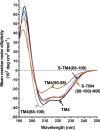Efflux by small multidrug resistance proteins is inhibited by membrane-interactive helix-stapled peptides
- PMID: 25425644
- PMCID: PMC4340417
- DOI: 10.1074/jbc.M114.616185
Efflux by small multidrug resistance proteins is inhibited by membrane-interactive helix-stapled peptides
Abstract
Bacterial cell membranes contain several protein pumps that resist the toxic effects of drugs by efficiently extruding them. One family of these pumps, the small multidrug resistance proteins (SMRs), consists of proteins of about 110 residues that need to oligomerize to form a structural pathway for substrate extrusion. As such, SMR oligomerization sites should constitute viable targets for efflux inhibition, by disrupting protein-protein interactions between helical segments. To explore this proposition, we are using Hsmr, an SMR from Halobacter salinarum that dimerizes to extrude toxicants. Our previous work established that (i) Hsmr dimerization is mediated by a helix-helix interface in Hsmr transmembrane (TM) helix 4 (residues (90)GLALIVAGV(98)); and (ii) a peptide comprised of the full TM4(85-105) sequence inhibits Hsmr-mediated ethidium bromide efflux from bacterial cells. Here we define the minimal linear sequence for inhibitor activity (determined as TM4(88-100), and then "staple" this sequence via Grubbs metathesis to produce peptides typified by acetyl-A-(Sar)3-(88)VVGLXLIZXGVVV(100)-KKK-NH2 (X = 2-(4'-pentenyl)alanine at positions 92 and 96; Z = Val, Gly, or Asn at position 95)). The Asn(95) peptide displayed specific efflux inhibition and resensitization of Hsmr-expressing cells to ethidium bromide; and was non-hemolytic to human red blood cells. Stapling essentially prevented peptide degradation in blood plasma and liver homogenates versus an unstapled counterpart. The overall results confirm that the stapled analog of TM4(88-100) retains the structural complementarity required to disrupt the Hsmr TM4-TM4 locus in Hsmr, and portend the general validity of stapled peptides as therapeutics for the disruption of functional protein-protein interactions in membranes.
Keywords: Cell-penetrating Peptide (CPP); Membrane Bilayer; Membrane Protein; Multidrug Transporter; Peptide Chemical Synthesis; Peptide Conformation; Protein Drug Interaction.
© 2015 by The American Society for Biochemistry and Molecular Biology, Inc.
Figures





References
-
- Wilson A. J. (2009) Inhibition of protein-protein interactions using designed molecules. Chem. Soc. Rev. 38, 3289–3300 - PubMed
-
- Higueruelo A. P., Jubb H., Blundell T. L. (2013) Protein-protein interactions as druggable targets: recent technological advances. Curr. Opin. Pharmacol. 13, 791–796 - PubMed
-
- Melnyk R. A., Partridge A. W., Deber C. M. (2002) Transmembrane domain mediated self-assembly of major coat protein subunits from Ff bacteriophage. J. Mol. Biol. 315, 63–72 - PubMed
-
- Fink A., Sal-Man N., Gerber D., Shai Y. (2012) Transmembrane domains interactions within the membrane milieu: principles, advances and challenges. Biochim. Biophys. Acta 1818, 974–983 - PubMed
-
- Ng D. P., Poulsen B. E., Deber C. M. (2012) Membrane protein misassembly in disease. Biochim. Biophys. Acta 1818, 1115–1122 - PubMed
Publication types
MeSH terms
Substances
Associated data
- Actions
Grants and funding
LinkOut - more resources
Full Text Sources
Other Literature Sources
Research Materials
Miscellaneous

